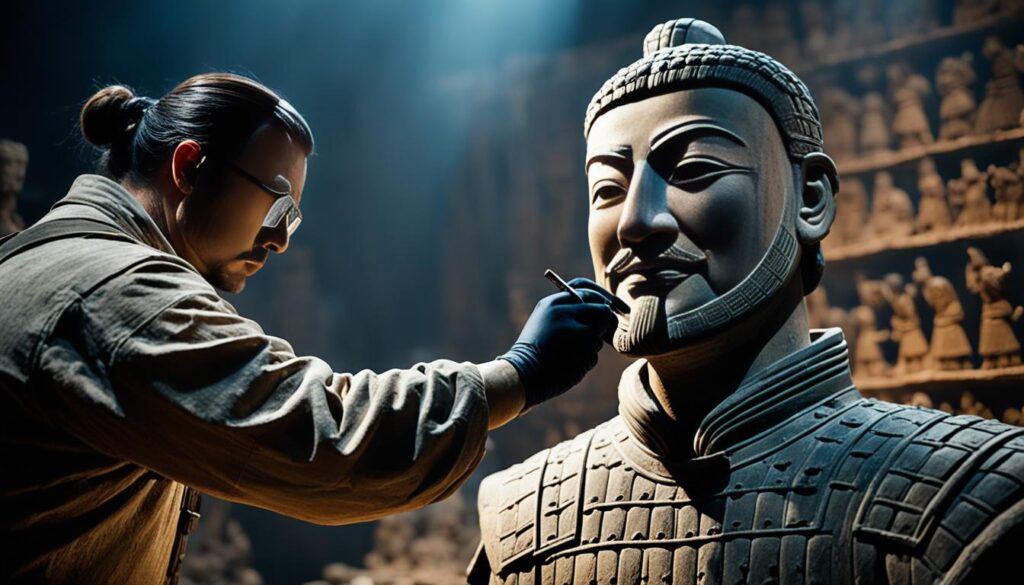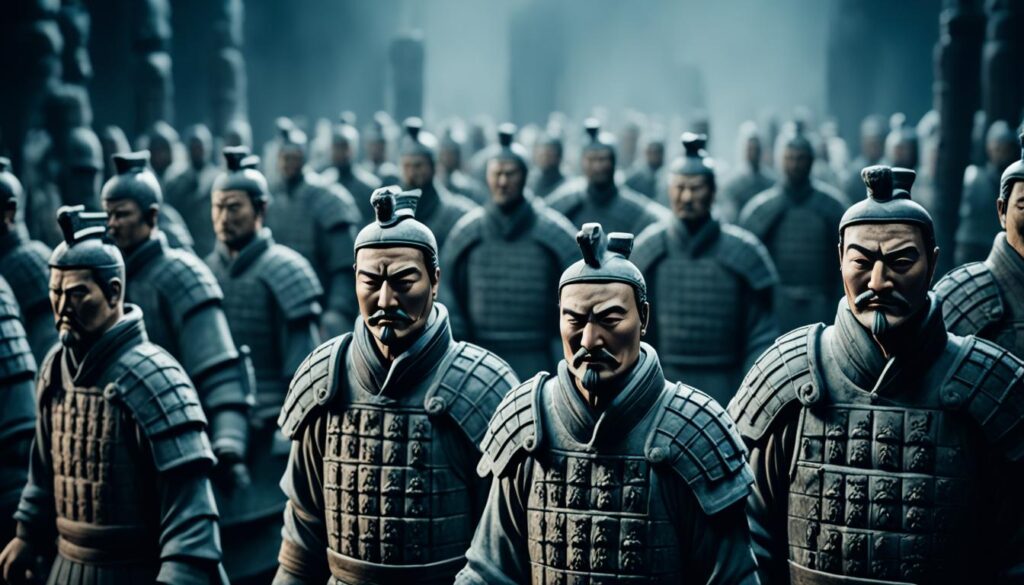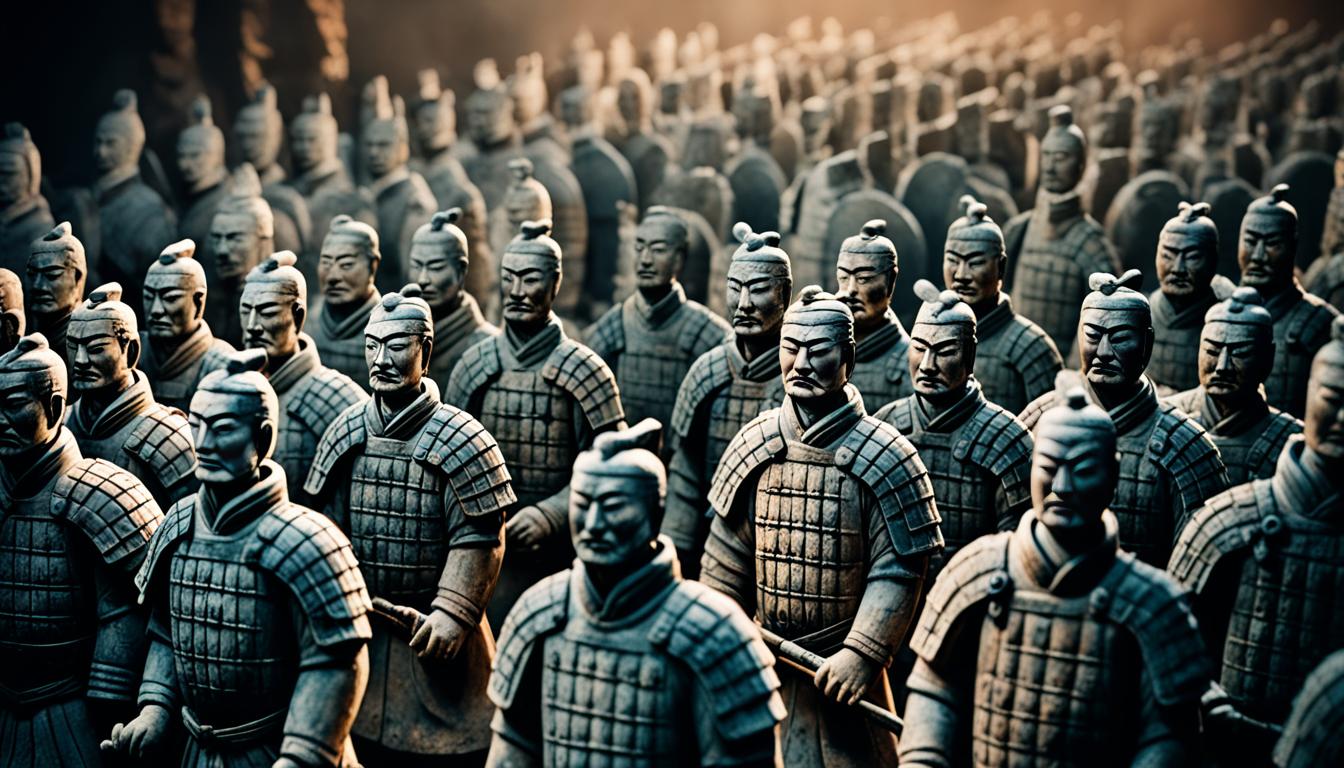Welcome to an intriguing journey into the world of ancient Chinese sculptures – the Terracotta Warriors! These remarkable historical artifacts from the Qin dynasty, buried along with Emperor Qin Shi Huang over 2,000 years ago, continue to captivate the imagination of people around the globe.
Located near the city of Xian in China, the Terracotta Army is a UNESCO World Heritage site and a testament to the skill and craftsmanship of ancient Chinese artisans. This extraordinary archaeological discovery has shed light on the art, culture, and history of ancient China, while also leaving experts puzzled by its mysteries and secrets.
Key Takeaways:
- The Terracotta Warriors are ancient Chinese sculptures dating back to the Qin dynasty.
- They were buried with Emperor Qin Shi Huang over 2,000 years ago.
- The Terracotta Army is a UNESCO World Heritage site and a significant archaeological discovery.
- These clay soldiers provide valuable insights into the art, culture, and history of ancient China.
- The mysteries surrounding the Terracotta Warriors continue to intrigue researchers and enthusiasts alike.
Unearthing the Terracotta Army

One of the most extraordinary archaeological discoveries in history unfolded in 1974 when a group of farmers in China, engaged in the humble task of well-digging, stumbled upon a collection of clay fragments. Unbeknownst to them, these fragments were the missing pieces of a terracotta warrior, part of what would soon be revealed as a monumental tomb complex.
The chance discovery of these clay fragments sparked a massive excavation effort, unearthing underground chambers that span an astounding 20 square miles. Believed to be the final resting place of Emperor Qin Shi Huang, the first emperor of China, these chambers revealed the awe-inspiring Terracotta Army and ignited extensive research into their origins and the mysteries surrounding the emperor’s tomb.
Over the years, this archaeological find has captivated the world with its magnificence and historical significance. The ancient Terracotta Army comprises thousands of life-sized figures, including soldiers, chariots, and horses. Each figure is meticulously crafted, displaying incredible attention to detail in their facial features, hairstyles, and weapons.
The discovery of the Terracotta Army not only showcases the artistic prowess and craftsmanship of ancient Chinese artisans but also raises numerous questions about the purpose of these clay soldiers and the secrets buried within the tomb complex. Who were the artisans responsible for creating this remarkable army? What was the significance of these grand underground chambers? And what drove Emperor Qin Shi Huang to commission such an awe-inspiring creation?
Unearthing the Terracotta Army was a monumental turning point in our understanding of ancient China’s history and culture.
Exploring the Monumental Tomb Complex
The sheer scale and complexity of the tomb complex are staggering. The underground chambers consist of vast arrays of warriors, painstakingly arranged in battle formations. Alongside the warriors are chariots, horses, and other intricate artifacts that offer glimpses into ancient Chinese military strategies, weaponry, and craftsmanship.
This historical revelation was made possible through the perseverance and curiosity of ordinary farmers, who unknowingly embarked on a journey that would reshape our understanding of ancient civilizations. Their accidental discovery forever changed our perception of Emperor Qin Shi Huang’s remarkable reign and left us with a profound admiration for the ingenuity and artistry of ancient China.
| Key Facts about the Terracotta Army | |
|---|---|
| Number of life-sized figures | Over 8,000 |
| Estimated area of the tomb complex | 20 square miles |
| Years of construction | Over 37 |
| Approximate number of involved laborers | Over 700,000 |
| Main materials used | Terracotta clay |
The First Emperor of China
Lorem ipsum dolor sit amet, consectetur adipiscing elit. Fusce eu dui justo. In tincidunt dignissim tellus, at fermentum sapien aliquet quis. Ut id dolor eu erat finibus dignissim ut a nisl. Aenean nibh ante, pellentesque quis tristique non, accumsan et est. Nullam vitae mi id velit eleifend ullamcorper ut at ex. Proin eget metus nec sem consectetur consectetur. Duis congue mauris quam.
Qin Shi Huang, also known as the First Emperor of China, ruled from 221-210 BC during the Qin dynasty. He is known for his conquests and unification of the various warring states of China, creating the first unified Chinese empire. Qin Shi Huang implemented significant administrative, economic, and social reforms, standardized measures, built infrastructure, and established a centralized government system. However, his rule was also characterized by harshness and suppression of intellectual and cultural expression.
| Qin Shi Huang | Qin Dynasty | Unifying China | Administrative Reforms | Centralized Government | Ancient Ruler |
|---|---|---|---|---|---|
| ✔ | ✔ | ✔ | ✔ | ✔ | ✔ |
The Magnificent Terracotta Army

The Terracotta Army is an awe-inspiring collection of over 8,000 life-size figures, including soldiers, chariots, and horses. Each figure showcases the meticulous craftsmanship and attention to detail that ancient Chinese craftsmen possessed. The clay soldiers are individually crafted with unique facial features, hairstyles, and equipped with weapons and armor, highlighting the incredible skill and artistry of the artisans.
The production process of these remarkable clay soldiers involved a complex series of steps. The figures were carefully molded, meticulously fired in kilns, and intricately painted to achieve a lifelike appearance. This level of detailed craftsmanship is a testament to the expertise of the ancient Chinese craftsmen who dedicated their time and skill to create such remarkable works of art.
Not only were soldiers represented in the Terracotta Army, but chariots and horses were also included. These chariots with their horses served as important elements in battle formations during ancient times. The inclusion of such intricate and realistic chariots and horses adds to the grandeur and realism of the entire display.
The production process of the Terracotta Army and the scale of labor required is truly remarkable. It is estimated that over 700,000 laborers participated in the creation of this astonishing masterpiece over a span of 37 years. This fact further emphasizes the significance and dedication that went into the creation of the army of clay soldiers.
| Key Features of the Terracotta Army | Overview |
|---|---|
| Battle Formation | Representation of soldiers, chariots, and horses arranged in a strategic battle formation |
| Detailed Craftsmanship | Individually crafted figures with unique facial features, hairstyles, and realistic weapons and armor |
| Weapons and Armor | Equipped with various weapons and detailed armor to represent the military might of ancient China |
| Chariots and Horses | Inclusion of intricately designed chariots and realistic horses, showcasing the importance of cavalry in ancient battles |
| Production Process | Complex molding, firing, and painting techniques used to create each individual clay soldier |
The Mysteries of the Terracotta Warriors
The purpose of the Terracotta Army remains a subject of debate among experts. Some believe that it was intended to protect Emperor Qin Shi Huang in the afterlife, while others speculate that it was meant to showcase his military power. The identity of the artisans who created the figures remains unknown, as no records have been found. Additionally, there are unanswered questions about the construction of the tomb complex and the burial practices of the emperor. These mysteries continue to intrigue researchers and add to the allure of the Terracotta Warriors.
One theory suggests that the army was created to accompany Emperor Qin Shi Huang in the afterlife, providing protection and assistance in the spiritual realm. This belief is supported by the fact that the soldiers were meticulously crafted with intricate details, highlighting their role as guardians in the otherworldly realm. The sheer number of soldiers further emphasizes their importance in ensuring the emperor’s safe passage into the afterlife.
Another theory proposes that the Terracotta Army served as a grand display of Emperor Qin Shi Huang’s military might and his desire to be remembered as a formidable ruler. By creating an army of life-size clay soldiers, the emperor sought to immortalize his military achievements and intimidate future generations. The army was strategically positioned in a battle formation, showcasing the emperor’s military prowess and dominance.
Despite extensive research, the identity of the artisans responsible for creating the Terracotta Army remains a mystery. No records or inscriptions have been discovered, leaving historians and archaeologists puzzled about the skilled craftsmen behind these magnificent sculptures. The level of detail and craftsmanship displayed in each figure suggests the involvement of highly skilled artisans, yet their names and backgrounds remain elusive.
Additionally, the construction process of the tomb complex raises intriguing questions. How were such complex structures built over 2,000 years ago? What techniques were utilized, and how were the massive quantities of clay and other materials transported? The construction of the tomb complex required meticulous planning and immense labor, involving thousands of workers over the span of several decades. Unraveling the secrets of this monumental undertaking holds the potential to shed light on the technological advancements and organizational skills of ancient Chinese civilization.
Unanswered Questions
- What was the true purpose of the Terracotta Army?
- Who were the anonymous artisans behind these masterpieces?
- How did the construction of the tomb complex unfold?
- What burial practices were employed for Emperor Qin Shi Huang?
The mysteries surrounding the Terracotta Warriors continue to captivate researchers and enthusiasts alike. As ongoing excavations and research efforts uncover new insights, we come closer to unraveling the secrets of Emperor Qin Shi Huang’s tomb and gaining a deeper understanding of the remarkable civilization that created these awe-inspiring works of art.
The Secrets of Emperor Qin Shi Huang’s Tomb
The tomb of Emperor Qin Shi Huang, the ruler of the Qin dynasty, holds many intriguing secrets that have yet to be fully explored. However, the excavation of the tomb poses numerous challenges, and concerns about preservation have limited the extent of exploration.
In 2012, advanced imaging technology revealed elevated levels of mercury in the soil surrounding the tomb, suggesting the presence of rivers of liquid mercury within. This discovery has raised environmental and health concerns, necessitating careful and cautious exploration in the event of a full excavation.
Despite these challenges, the potential treasures and artifacts hidden within the tomb are undoubtedly of immense value. The tomb is believed to contain a wealth of ancient artifacts that could shed light on the culture and history of ancient China.
“The secrets buried within the tomb of Emperor Qin Shi Huang hold the key to unlocking the mysteries of ancient China and its rich heritage.”
The full extent of the treasures in the tomb remains unknown, leaving researchers eager to delve deeper into its ancient chambers. If successfully excavated, this monumental discovery could reveal invaluable insights into the art, craftsmanship, and daily life of ancient China.
To provide a glimpse into the potential riches, artifacts, and the challenges of this excavation, the following table summarizes some of the speculated treasures that could be found within the tomb:
| Potential Treasures and Artifacts |
|---|
| Gold and jade ornaments |
| Rare and valuable gemstones |
| Ancient weapons and armor |
| Elaborate chariots |
| Exquisite pottery and ceramics |
| Priceless scrolls and historic texts |
With the potential for such incredible treasures, the secrets of Emperor Qin Shi Huang’s tomb continue to captivate explorers, historians, and archaeologists alike.
Conclusion
The Terracotta Army is an archaeological marvel that holds immense significance in understanding the ancient culture and history of China. This extraordinary discovery has granted us invaluable insights into the artistic prowess, military might, and social customs of the Qin dynasty. The enduring legacy of the Terracotta Army continues to mesmerize people around the world, fueling our curiosity and fascination with ancient civilizations.
Unveiling the mysteries surrounding the Terracotta Warriors has become a captivating quest for researchers and historians. With ongoing efforts in research and exploration, we hope to uncover further secrets hidden within the tomb complex of Emperor Qin Shi Huang. These secrets not only shed light on the remarkable craftsmanship and engineering skills of ancient Chinese artisans but also provide deeper understanding of the mindset and aspirations of an emperor who sought eternal protection.
As the legacy of the Terracotta Army endures, we are reminded of the rich heritage and profound influence of ancient China. This awe-inspiring collection of clay soldiers serves as a testament to the greatness of a civilization that left an indelible mark on history. By preserving and studying this remarkable archaeological find, we gain invaluable lessons about our past, and our shared humanity.
FAQ
What is the Terracotta Army?
How was the Terracotta Army discovered?
Who was Emperor Qin Shi Huang?
How many figures are in the Terracotta Army?
What is the purpose of the Terracotta Army?
Who created the Terracotta Army?
What are the mysteries surrounding the Terracotta Warriors?
Why has the tomb of Emperor Qin Shi Huang not been fully explored?
Why is the Terracotta Army significant?
Source Links
- https://www.barnesandnoble.com/w/the-terracotta-warriors-edward-burman/1127258844
- https://www.historyskills.com/classroom/year-7/terracotta-warriors/
- https://suitcaseinspain.com/exploring-the-terracotta-warriors-exhibition-at-the-marq/

